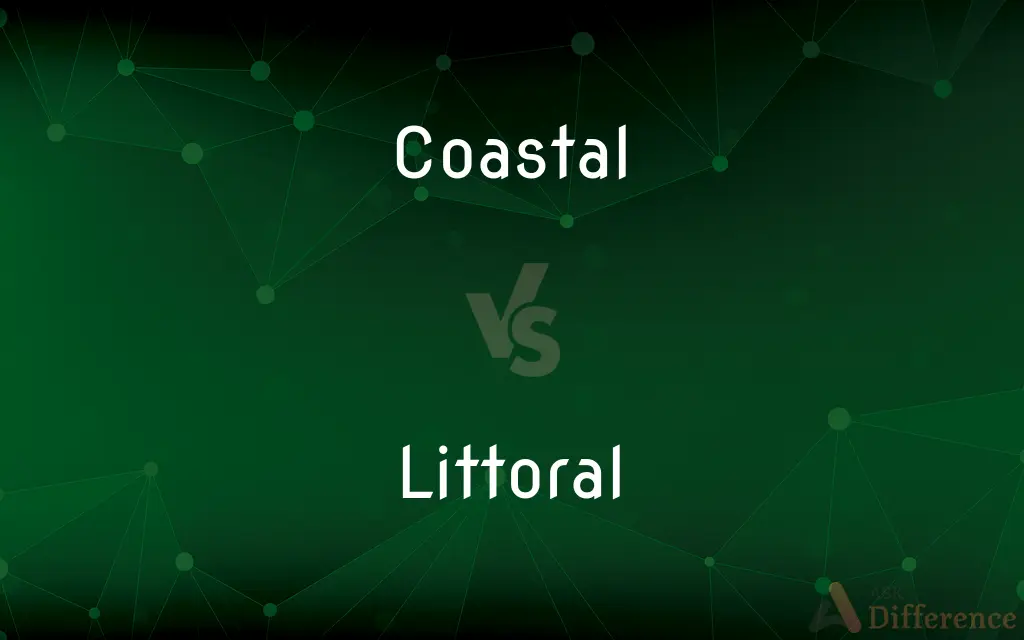Coastal vs. Littoral — What's the Difference?
By Fiza Rafique & Urooj Arif — Updated on April 2, 2024
Coastal areas are near the coast, often referring to broader regions, while littoral zones are specifically where water meets land.

Difference Between Coastal and Littoral
Table of Contents
ADVERTISEMENT
Key Differences
Coastal areas are defined by their proximity to the ocean or sea, covering a broad region that can extend inland from the shoreline. They are influenced by marine conditions but can include a variety of ecosystems, such as beaches, estuaries, and coastal forests. Littoral zones, on the other hand, are specifically the parts of the coast that are in the immediate vicinity of the shoreline, including the area that is submerged at high tide and exposed at low tide, also known as the intertidal zone.
While coastal regions can encompass both marine and terrestrial environments, extending to areas that might not be directly influenced by the tide, littoral areas are characterized by their direct interaction with tidal movements. This makes littoral zones dynamic environments with unique ecological communities adapted to regular changes in water level and salinity.
Coastal zones are important for various human activities, including settlement, tourism, and industry, offering economic benefits but also facing challenges such as erosion and flooding. Littoral zones are crucial for marine biodiversity, serving as habitats for numerous species of plants, animals, and microorganisms that are adapted to the varying conditions of wet and dry periods.
In terms of management, coastal areas often require integrated approaches that consider both land and marine aspects to address issues like coastal erosion, sea level rise, and habitat conservation. Littoral zones, however, specifically need conservation efforts focused on preserving the delicate balance of their ecosystems, which are highly sensitive to human impact and natural changes.
While coastal regions can be affected by a broader range of environmental and human factors, including urban development, pollution, and climate change, littoral zones face specific pressures from activities like coastal construction, pollution, and overfishing, which can directly alter their physical and ecological characteristics.
ADVERTISEMENT
Comparison Chart
Definition
Pertaining to land near the shore of an ocean or sea.
Specifically refers to the part of the coast right by the edge of the sea, including the intertidal zone.
Location
Extends inland from the shoreline, encompassing both marine and terrestrial environments.
Directly adjacent to the shoreline, affected by tidal movements.
Ecosystems
Includes a variety of ecosystems such as beaches, estuaries, and coastal forests.
Characterized by unique ecological communities adapted to tidal changes.
Human Activities
Important for settlement, tourism, industry, and faces challenges like erosion and flooding.
Sensitive to impacts like construction, pollution, and overfishing due to its proximity to the water.
Conservation Focus
Requires integrated land and marine management approaches.
Needs specific efforts to preserve ecosystems sensitive to physical and ecological changes.
Compare with Definitions
Coastal
Economic importance.
Coastal areas are hubs for tourism, fishing, and maritime industries.
Littoral
Shoreline zone.
Littoral environments are directly influenced by tidal movements.
Coastal
Broader region.
Coastal ecosystems can include areas significantly inland from the beach.
Littoral
Unique biodiversity.
Littoral zones host species adapted to fluctuating salt and freshwater conditions.
Coastal
Varied ecosystems.
Coastal zones support diverse habitats, from sandy beaches to rocky cliffs.
Littoral
Directly affected by tides.
Littoral ecosystems are dynamic, changing with the ebb and flow of the tide.
Coastal
Environmental management.
Coastal management strategies aim to mitigate erosion and promote sustainable development.
Littoral
Conservation needs.
Littoral zones require protection from coastal development and pollution to preserve their unique ecosystems.
Coastal
Near the shore.
Coastal cities often face challenges like storm surges and erosion.
Littoral
Intertidal focus.
The littoral zone includes the area exposed during low tide and submerged at high tide.
Coastal
Land next to the sea; the seashore.
Littoral
Of or on a shore, especially a seashore
A littoral property.
The littoral biogeographic zone.
Coastal
The water near this land
Fish of the Atlantic coast.
Littoral
A coastal region; a shore.
Coastal
Coast The Pacific coast of the United States.
Littoral
The region or zone between the limits of high and low tides.
Coastal
A hill or other slope down which one may coast, as on a sled.
Littoral
Of or relating to the shore, especially the seashore.
Coastal
The act of sliding or coasting; slide.
Littoral
A shore.
Coastal
(Obsolete) The frontier or border of a country.
Littoral
The zone of a coast between high tide and low tide levels.
Coastal
To slide down an incline through the effect of gravity.
Littoral
Of or pertaining to a shore, as of the sea.
Coastal
To move without use of propelling power.
Littoral
Inhabiting the seashore, esp. the zone between high-water and low-water mark.
Coastal
To act or move aimlessly or with little effort
Coasted for a few weeks before applying for a job.
Littoral
The region of the shore of a lake or sea or ocean
Coastal
(Nautical) To sail near or along a coast.
Littoral
Of or relating to a coastal or shore region
Coastal
To sail or move along the coast or border of.
Coastal
(geography) Relating to the coast; on or near the coast.
Coastal town
Coastal breeze
Coastal elites
Coastal
Of or pertaining to a coast.
Coastal
Of or relating to a coast;
Coastal erosion
Coastal
Located on or near or bordering on a coast;
Coastal marshes
Coastal waters
The Atlantic coastal plain
Common Curiosities
How do coastal and littoral zones differ?
Coastal zones cover a broader area that includes both land and marine environments near the shore, whereas littoral zones specifically refer to the area right by the water's edge, including the intertidal zone.
What defines a coastal area?
A coastal area is defined by its proximity to the ocean or sea, encompassing both land and marine spaces near the shore.
What is the littoral zone?
The littoral zone is the part of the coast directly adjacent to the shoreline, including the intertidal area affected by tidal movements.
Why are littoral zones important?
Littoral zones are crucial for biodiversity, providing habitat for many species adapted to the unique conditions of fluctuating water levels.
Can littoral zones be found in freshwater environments?
While typically associated with marine environments, the term littoral can also apply to the shorelines of freshwater bodies, referring to the area near the shore.
How does climate change impact coastal and littoral zones?
Climate change affects these areas through sea level rise, increased storm intensity, and changes in tidal patterns, posing risks to habitats and human settlements.
What conservation efforts are important for littoral zones?
Conservation efforts for littoral zones focus on protecting habitats from pollution, development, and other human impacts to preserve their unique biodiversity.
How are coastal areas managed?
Coastal areas are managed through integrated strategies that consider environmental, social, and economic factors to address issues like erosion and promote sustainable development.
What challenges do coastal areas face?
Coastal areas face challenges such as erosion, flooding, pollution, and habitat loss due to human activities and climate change.
Are all coastal areas considered littoral?
Not all coastal areas are considered littoral; only those parts of the coast directly adjacent to the shoreline, including the intertidal zone, are littoral.
What role do humans play in affecting littoral zones?
Human activities such as coastal development, pollution, and overfishing can significantly impact the delicate ecosystems of littoral zones.
How do tidal movements affect littoral zones?
Tidal movements create a dynamic environment in littoral zones, influencing the distribution of organisms and the types of habitats available.
What is coastal erosion, and why is it a concern?
Coastal erosion is the process of wearing away land by the sea, which can lead to loss of habitat, property damage, and increased vulnerability to storms.
Why are coastal areas economically important?
Coastal areas are economically important due to their role in tourism, fishing, maritime industries, and as locations for settlements and infrastructure.
What makes littoral zones unique in terms of biodiversity?
The unique conditions of fluctuating water levels in littoral zones create habitats for specialized species, making these areas hotspots for biodiversity.
Share Your Discovery

Previous Comparison
Insight vs. Knowledge
Next Comparison
Significance vs. RelevanceAuthor Spotlight
Written by
Fiza RafiqueFiza Rafique is a skilled content writer at AskDifference.com, where she meticulously refines and enhances written pieces. Drawing from her vast editorial expertise, Fiza ensures clarity, accuracy, and precision in every article. Passionate about language, she continually seeks to elevate the quality of content for readers worldwide.
Co-written by
Urooj ArifUrooj is a skilled content writer at Ask Difference, known for her exceptional ability to simplify complex topics into engaging and informative content. With a passion for research and a flair for clear, concise writing, she consistently delivers articles that resonate with our diverse audience.
















































